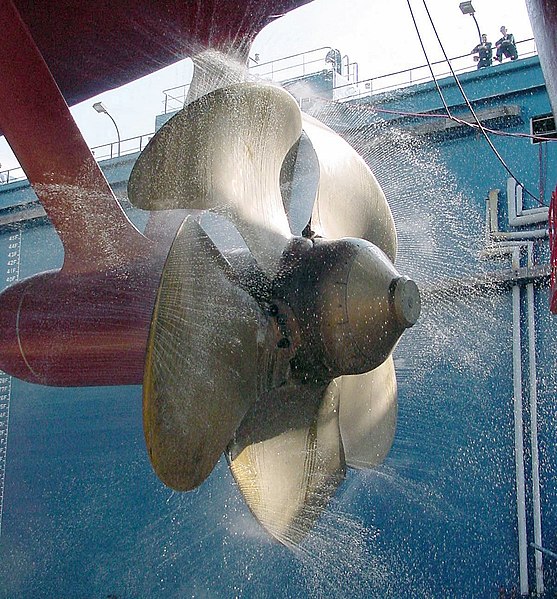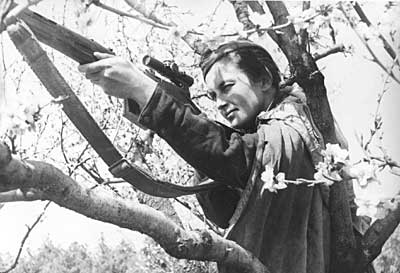This is a shot of the USS Spruance in drydock. Ticonderoga-class cruisers were pretty much built on the same hull form. The big bulge at the bottom of the bow is the sonar dome. On a Tico, the bottom of the dome is 33' underwater.

This is a sonar dome for a SQS-53 sonar. A rubber window, which is a very large radial rubber belt, goes in the gap. The metal base underneath is known as the "banjo." Those black squares are transducer elements.

This is one of the screws from an Arleigh Burke class DDG. The Burke class uses the same engine as the Ticos, the LM-2500 gas turbine, so odds are the screws look about the same. ("Screws" are what you might call "props.")
 Look closely at the base of the blades and you can see that they can be rotated. Unlike steam turbines, gas turbines cannot be reversed (the LM-2500 is, at the core, a jet engine from a jumbo jet), so if you want to back up, you have to twist the blades. Indeed, from 0-12 knots or so, the turbines rotate at the same speed; so at slow speeds, the ship's speed is controlled by the pitch of the screws. When the ship goes faster than that, the turbines speed up and the pitch stays the same.
Look closely at the base of the blades and you can see that they can be rotated. Unlike steam turbines, gas turbines cannot be reversed (the LM-2500 is, at the core, a jet engine from a jumbo jet), so if you want to back up, you have to twist the blades. Indeed, from 0-12 knots or so, the turbines rotate at the same speed; so at slow speeds, the ship's speed is controlled by the pitch of the screws. When the ship goes faster than that, the turbines speed up and the pitch stays the same.The Port Royal went aground in 22 feet of water. A Tico cruiser has a displacement of over 9,000 tons. Take 9,000 tons of ship, run it into hard ground that is 11 feet shallower than the depth of water that the ship draws and Bad Things are going to happen.
Really bad things.
This is the aft vertical launcher for a Tico cruiser. Under each of those doors is a silo for a SM-2/3 ER missile. The missiles are just a skosh over 26 feet long.
 If you were to twist the hull a lot, as you might in a grounding, you could twist the launcher doors out of true. That is a Bad Thing.
If you were to twist the hull a lot, as you might in a grounding, you could twist the launcher doors out of true. That is a Bad Thing.Last night, I posted that "officials" said that the screws were damaged and that the tips were"'sheared off." Those blades, as you can see, are one-piece right down to the hubs.
What I am told is this:
The blades for the screws were not damaged, they were destroyed. The screw blades were sheared off. The shafts were bent enough that the shaft bearing, which probably are large babbit-bearings, were damaged. The stern tube seals were damaged and the ship was taking on water into the shaft alleys. The base of the rudders were also grounded, driving the rudders up or twisting them. The reduction gears (between the gas turbines and the screw shaft) may have been damaged. One or more of the gas turbine engines might have been damaged. I don't know if there is a shear coupling in the power train between the gas turbines and the shaft; there could be, but it would have to be a huge-ass thing., so I tend to doubt it.
As you might imagine, the sonar dome was toast. The banjo was bent up, the transducer itself is probably badly damaged.
The twisting of the hull reportedly damaged at least one of the vertical rocket launchers and cracked the firemain system. A number of bulkheads throughout the ship were twisted and buckled. A number of fuel tanks leaked, though apparently not into the sea. Hull members (I-beams welded to hull plating) are likely twisted, cracked and/or buckled.
The firemain system is composed of piping that is pressurized with seawater; it is used for cooling as well as fire-fighting. When a ship runs around, the firemain can get clogged with bottom debris. The firemain on the Port Royal supposedly is clogged with sand and coral debris. Coral and sand are extremely abrasive, so the firemain pump(s) that were online at the time of the grounding probably will need to be torn down. The valves throughout the firemain may all need to be checked and the piping itself will have to be flushed.
Seawater is also used for cooling. The air-conditioning units on the ship (there are several large units) use seawater for cooling and those are probably all clogged with sand and coral. There is a lot of other damage to the ship that in other circumstances would be a serious "oh, shit," but now are almost minor in comparison.
The Port Royal was in her first day of sea trials after spending two months in drydock. She will be back in drydock for a very long time. The damage doesn't stop there, as the long-range scheduling committments for the ship will have to be filled by other ships, which will find their deployments extended and/or moved up. Maintenance work on other ships will be deferred or delayed, both because the Port Royal is occupying a drydock and because the work will suck up dollars already allocated. Given the amount of work that may be required to fix her up, it's not beyond the realm of possibility that the Navy may decide to patch her up for now to make sure she doesn't sink, decommission her, refloat her, store her along a pier and fix her up later once money and resources are identified. (That's what the Navy did when the USS Belknap burned in the 1970s.)
And, of course, a number of the officers of the Port Royal had better start thinking of what they are going to do next, as their careers are over.


